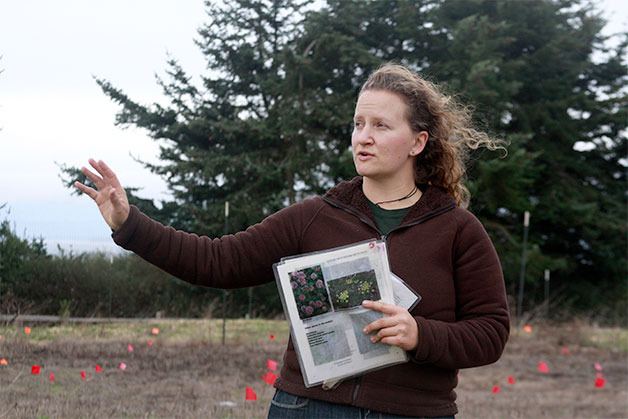Off to the side of Engle Road in Coupeville, about a mile from the Camp Casey Conference Center, is a long, narrow stretch of land that overlooks Admiralty Inlet.
Surrounded by scenic beauty, the property is otherwise unremarkable, partially hidden by hedgerows and barren all but for an occasional fir tree.
Yet to the Whidbey Camano Land Trust and other groups interested in prairie restoration, this land is gold.
Named the Naas Prairie Unit of the Admiralty Inlet Preserve, the land was identified as a prime location for the land trust to place its efforts to try to recover rare plant and animal species that call prairies home.
Driving the effort through federal and state grants is the Golden Paintbrush, a perennial herb that is listed as threatened under the Federal Endangered Species Act and endangered in Washington by the Washington Natural Heritage program.

Since the land that makes up the Naas Prairie Unit was acquired by the land trust in 2005, prairie restoration efforts have taken place with clearing, burns and plantings of native prairie plants in an attempt to create a habitat friendly to Golden Paintbrush with hopes to attract rare animal species such as the Taylor’s Checkerspot butterfly.
An effort started this week to plant more than 30,000 native prairie plants over the next two weeks with an opportunity for volunteers to help from 9 a.m. to noon, Saturday, Nov. 1.
“We’re following a federal recovery plan,” said Patricia Powell, executive director of the Whidbey Camano Land Trust. “We’re working in concert with the state and federal government to recover the (Golden Paintbrush) species.”
Whidbey Island is one of the few places in the world where Golden Paintbrush grow. However, the rich, loamy soil they require in prairie settings is scarce.
Less than 1 percent of native prairies on Whidbey Island, or less than 80 acres, remain.
It is estimated that about 10,000 acres of prairies existed on the island at about the time of American settlement in 1850.
“It’s an important plant to take care of, especially with prairies being so rare,” said Jessica Larson, a land steward with the land trust.
The Naas unit, named after Dorothy Naas, is 33 acres. Last year, the land trust acquired the 46-acre Heritage Forest Unit, which makes up the southern half of the Admiralty Inlet Preserve. That unit includes a small portion of prairie land where restoration efforts will take place in the future.
A survey of Golden Paintbrush in 2005 found 58 plants at the Naas prairie unit.

A count taken in May revealed that number had jumped to 4,250.
The recovery efforts are part of a joint plan involving Washington, Oregon and British Columbia centered on restoring prairie habitat, Powell said.
“Here in Washington, the U.S. Fish & Wildlife Service would like to see 20 sites that have 5,000 Golden Paintbrush for at least five years,” she said. “That’s the idea.”
Populations of Golden Paintbrush are found in only 11 sites in the world, including nine in the United States. Of those, five are on north and central Whidbey Island.


